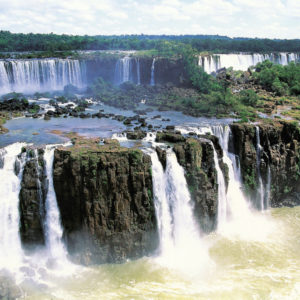Video courtesy of Visit Brazil tourism
Right in the heart of South America, and embraced by unspoiled wetlands, lush Amazonic jungles, stunning beaches, historic sites and iconic monuments, lies the continent’s largest country: Brazil. When you think of Brazil you imagine vivid colors, unique fauna and lively music comes to mind, and our featured itineraries have transformed these Brazilian sensations into astonishing travel experiences. We have combined the unique flavors of Brazil with luxury hotel accommodation, first-class transportation and insider access opportunities to create everlasting memories.
In visiting Brazil, you open up a wealth of travel opportunities, not only in this exotic country but also because it is so easy to combine a trip with other neighboring, and equally as fascinating, countries.
Top destinations: Rio de Janeiro, Iguassu Falls, Salvador
Brazil is an all year round destination made up of several different ecosystems and climates which mostly offer good weather year-round. Hottest months are from December to March, and Brazil’s peak summer, and high season is between Christmas and Carnival (in mid-February or early March). Brazil’s spring (September to November) is a great time to visit taking advantage of warm days in São Paulo, Iguaçu, and Rio, and tropical heat everywhere else. Another good period for a visit is after Carnaval (early to mid-March, depending on the dates) through May, when you can take advantage of low-season prices, particularly in hotels, while still enjoying good weather. Ultimately there are not months where weather is so bad that it deters travelers, even during the “winter” months of June-August there are picture perfect beach days in Rio and even on the coldest days it never freezes.
Northeast
From Salvador north is warm year-round, often with a pleasant breeze coming off the ocean. Temperatures hover between the upper 20s to mid-30s Celsius (low 80s and mid-90s Fahrenheit). The winter months (June-July) are slightly wetter, but even then the amount of rain is limited — a quick shower that cools things down briefly before giving way to more sunshine.
Amazon
Located closer to the equator is generally hot and humid year-round, with temperatures hovering around the mid- to high 30s Celsius (mid-90s to low 100s Fahrenheit). The dry season lasts from June to December and is often called “summer” by the locals as it is hot and sunny. As the rivers recede, beaches and islands reappear. The wet season typically runs from December to May and is referred to as “winter.” The humidity is higher in the rainy season, building up over the course of the day to produce a heavy downfall almost every afternoon. Even then, however, mornings and early afternoons can be clear and sunny.
Pantanal
The Pantanal also has distinct seasons with advantages for each.
The climate is tropical in Pantanal, the summers are hot (around 32ºC) and winter is cool and dry, averaging 21ºCs. November to March are the rainiest months and June to August are the driest. The climate can be divided into four seasons: dry season (June-October), rainy season (November to December), summer – wet season (January-March) and spring – intermediate season (April and May). The Pantanal can be visited year-round. The driest months between June and October, are best for wildlife viewing, particularly for larger mammals.
Southern Brazil
São Paulo has a similar climate to Rio’s, hot in the summer and mild in winter. As São Paulo sits atop a plateau at approximately 700m (2,300 ft.) of elevation it can get pretty chilly, with lows June through September sometimes reaching 12°C (54°F). South of São Paulo, things get even colder in the winter. In Florianópolis, many restaurants and even some hotels shut down for the winter season. Also, in the mountain resort of Petrópolis and the historic towns of Ouro Preto and Tiradentes, the winder months can bring temperatures down to (5°C/41°F), which is pretty much as cold as it gets.
Showing the single result
Need Assistance?
800-227-5317 | sales@pacific-destinations.com
Tell us where and when you want to go and we’ll give your request our immediate attention! No high pressure sales, just straight talk and sound advice!

